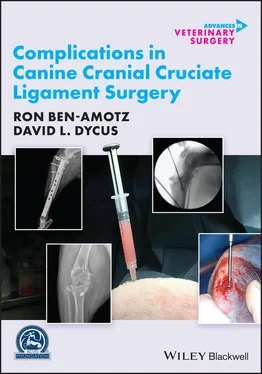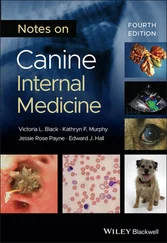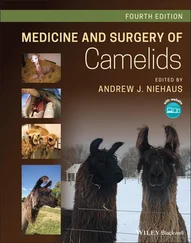71 71. Singh, A., Walker, M., Rousseau, J., and Weese, J.S. (2013). Characterization of the biofilm forming ability of Staphylococcus pseudintermedius from dogs. BMC Vet. Res. 9: 93.
72 72. Donlan, R.M. (2001). Biofilm formation: a clinically relevant microbiological process. Clin. Infect. Dis. 33: 1387–1392.
73 73. Walker, M., Singh, A., Nazarali, A. et al. (2016). Evaluation of the impact of methicillin‐resistant Staphylococcus pseudintermedius biofilm formation on antimicrobial susceptibility. Vet. Surg. 45: 968–971.
74 74. Azab, M.A., Allen, M.J., and Daniels, J.B. (2016). Evaluation of a silver‐impregnated coating to inhibit colonization of orthopaedic implants by biofilm forming methicillin‐resistant Staphylococcus pseudintermedius. Vet. Comp. Orthop. Traumatol. 29 (6): 347–350.
75 75. Arciola, C.R., Campoccia, D., Speziale, P. et al. (2012). Biofilm formation in Staphylococcus implant infections. A review of molecular mechanisms and implications for biofilm‐resistant materials. Biomaterials 33 (26): 5967–5982.
76 76. Konig, L., Klopfleisch, R., Kershaw, O., and Gruber, A.D. (2015). Prevalence of biofilms on surgical suture segments in wounds of dogs, cats, and horses. Vet. Pathol. 52 (2): 295–297.
77 77. McCagherty, J., Yool, D.A., Paterson, G.K. et al. (2020). Investigation of the in vitro antimicrobial activity of triclosan‐coated suture material on bacteria commonly isolated from wounds in dogs. Am. J. Vet. Res. 81 (1): 84–90.
78 78. Morrison, S., Singh, A., Rousseau, J. et al. (2015). Impact of polymethylmethacrylate additives on methicillin‐resistant Staphylococcus pseudintermedius biofilm formation in vitro. Am. J. Vet. Res. 76 (5): 395–401.
79 79. Boothe, D.M. and Boothe, H.W. Jr. (2015). Antimicrobial considerations in the perioperative patient. Vet. Clin. North Am. Small Anim. Pract. 45 (3): 585–608.
80 80. Anderson, M.E.C. (2015). Contact precautions and hand hygiene in veterinary clinics. Vet. Clin. North Am. Small Anim. Pract. 45 (2): 343–360.
81 81. Bratzler, D. (2005). Antimicrobial prophylaxis for surgery: an advisory statement from the National Surgery Infection Prevention Project. Am. J. Surg. 189: 395–404.
82 82. Whittem, T.L., Johnson, A.L., Smith, C. et al. (1999). Effect of perioperative prophylactic antimicrobial treatment in dogs undergoing elective orthopedic surgery. J. Am. Vet. Med. Assoc. 215: 212–216.
83 83. Weese, J.S. and Halling, K.B. (2006). Perioperative administration of antimicrobials associated with elective surgery in dogs: 83 cases (2003–2005). J. Am. Vet. Med. Assoc. 229 (1): 92–95.
84 84. Hagen, C.R.M., Singh, A., Weese, J.S. et al. (2020). Contributing factors to surgical site infection after tibial plateau leveling osteotomy: a follow‐up retrospective study. Vet. Surg. 49: 930–939.
85 85. Burgess, B.A. (2019). Prevention and surveillance of surgical infections: a review. Vet. Surg. 48: 284–290.
86 86. Stickney, D.N.G. and Mankin, K.M.T. (2018). The impact of postdischarge surveillance on surgical site infection diagnosis. Vet. Surg. 47: 66–73.
87 87. Centers for Disease Control and Prevention (2020). Surgical Site Infection (Event). Atlanta, GA: CDC.
88 88. Nicoll, C., Singh, A., and Weese, J.S. (2014). Economic impact of tibial plateau leveling osteotomy surgical site infection in dogs. Vet. Surg. 43: 899–902.
3 Identification, Addressing, and Following Up on Surgical Site Infection After Cranial Cruciate Ligament Stabilization
Katie L. Hoddinott, J. Scott Weese, and Ameet Singh
Prompt and accurate diagnosis of surgical site infections (SSIs) is important for patient management and facility infection control. Identifying infections promptly allows for early intervention. Differentiation of SSI from inflammation helps avoid unnecessary treatment. A good understanding of infection rates and early identification of increases in infection rates can allow for an earlier investigation and intervention. Therefore, SSI surveillance is a critical area for any surgeon, surgical team, and facility.
3.2 Identification of Surgical Site Infections
A superficial incisional SSI is confined to the skin and subcutaneous tissues of the incision and must be differentiated from cellulitis. The Centers for Disease Control and Prevention (CDC) defines cellulitis as localized redness, heat, and swelling, without purulent discharge or identification of microorganisms [1]. The clinical features associated with cellulitis are often identified in postoperative wounds and presumed to indicate SSI without performing diagnostic testing to identify a causative organism, thus confirming an active SSI [2, 3]. Subsequently, when reviewing the literature, a category such as “infection‐inflammation” may be reported, making it difficult to accurately detect and report SSI rates based on CDC definitions [2, 3]. One such study including the infection‐inflammation category defines infection‐inflammation as the presence of purulent discharge, a localized abscess or fistulous tract associated with the incision or the presence of three or more of the following: redness, swelling, heat, pain, serous discharge, and dehiscence [3]. While some of the cases collected in this category may appropriately represent an SSI, it does not distinguish SSI from cellulitis and as such may be falsely increasing the reported SSI rates. Other studies have reported SSI rates based on CDC definitions including positive culture results, while also reporting an infection‐inflammation rate to encompass those patients presenting with abnormal incisions [4].
Early detection and intervention for SSIs is critical. Löfqvist et al. identified marked elevations of serum C‐reactive protein (CRP) and serum amylase A (SAA) 6 days following tibial plateau leveling osteotomy (TPLO) [5]. The cut‐off values reported (CRP >43.9 mg/L, SAA >63.8 mg/L) may be used for patients both with and without clinical evidence of an active SSI and may therefore lead to earlier detection of subclinical SSIs [5]. While these serum markers may be able to identify subclinical SSIs, the clinical utility of this test is low as there are no clinical criteria that can be monitored to determine which patients to test. Following discharge from the hospital, owners should be advised to monitor the surgical site for evidence of localized swelling, pain, heat, or erythema. If any of these signs are detected, evaluation by a veterinarian should be sought.
Table 3.1 Swabbing techniques.
| Swabbing technique |
Collection method |
| Levine technique |
The swab is rotated over 1 cm 2for 5 sec with sufficient pressure to exude fluid from the tissues |
| Z‐technique |
The swab is rotated as it is moved from margin to margin, without touching the skin edges, in a 10‐point fashion |
Clinically, identification of SSIs will require gross reassessment of the surgical site to differentiate between cellulitis and infection as defined above and allow for collection of aseptic samples to identify microorganisms via cytology or bacterial culture. This may include direct swabbing of the wound or deep fine needle local aspirates. Before collecting a direct swab, the wound should be lavaged with sterile saline and any devitalized tissues debrided. The swab should be collected from the healthiest appearing portion of the wound bed. Two direct swabbing techniques have been described and are recommended to improve the chances of collecting a representative sample ( Table 3.1). Of the two, the Levine technique ( Figure 3.1) is considered superior [6]. When collecting a deep local fine needle aspirate, known regions of contamination should be avoided and the skin should be cleaned with alcohol to reduce the risk of skin contaminants. If microorganisms are identified cytologically from your sample, a bacterial culture and susceptibility test is recommended to further guide therapy. Radiographic assessment for evidence of lucency surrounding implants or evidence of osteomyelitis should also be considered to determine the extent of the suspected SSI. Radiographic evidence to support a deep SSI causing osteomyelitis may include periosteal reaction and bone lysis surrounding the implants ( Figure 3.2).
Читать дальше












